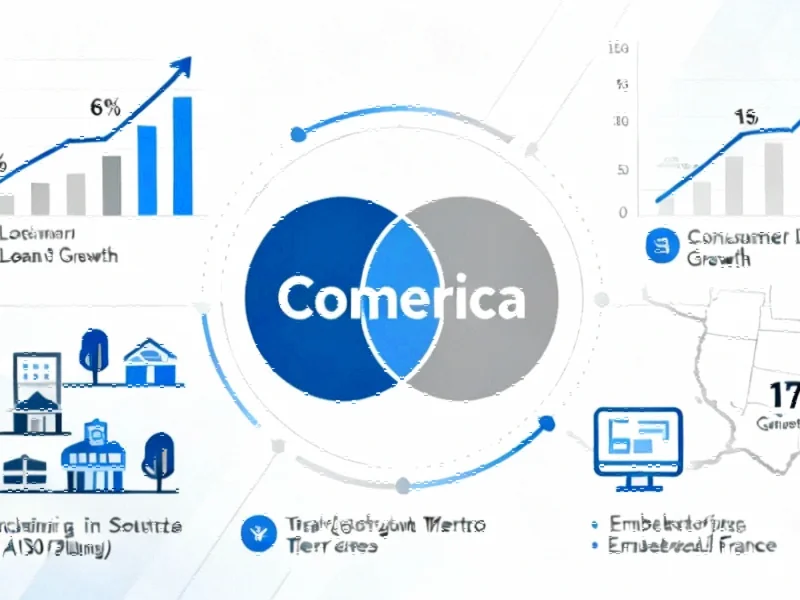Strategic Banking Moves Signal New Era for Industrial Technology Financing
As Fifth Third Bancorp moves forward with its planned Comerica acquisition, the banking institution is positioning embedded finance as a central growth driver, particularly for industrial and technology sectors. The merger, which CEO Tim Spence describes as creating “a well-diversified, even more profitable company with even better long-term growth,” represents a significant consolidation in regional banking with specific implications for industrial technology companies seeking financial services integration.
Embedded Finance Platform Shows Strong Momentum
Fifth Third’s embedded finance platform, particularly through its Newline division, demonstrated impressive growth with revenues increasing 31% and deposits growing by more than $1 billion to reach $3.9 billion. “We expect New Line to sustain its growth as transactional activity ramps from the rollout of Stripe Treasury and many other category-defined payments customers who build on New Line’s APIs,” Spence noted during the earnings call.
This growth in embedded financial services coincides with broader industry developments that are reshaping how industrial companies access capital and financial infrastructure. The ability to integrate banking services directly into business platforms represents a significant evolution in financial technology that particularly benefits manufacturing and industrial sectors.
Branch Expansion Meets Digital Innovation
While Fifth Third plans significant physical expansion—adding 13 branches in the Southeast with 27 more planned by 2025, plus 150 branches to Comerica’s Texas footprint—the bank continues to emphasize digital transformation. The company’s consumer households in the Southeast grew by 7% year-over-year, “more than four times the rate of underlying market growth,” according to Spence.
This dual approach of physical presence and digital capability expansion reflects a strategic balance that serves both traditional industrial clients and newer technology-driven manufacturers. The combination will create presence in “17 of the fastest growing large U.S. metro areas,” providing comprehensive coverage for industrial companies operating across multiple regions.
Specialized Lending Platforms Drive Sector Growth
Fifth Third’s Provide platform, a FinTech lending solution for practice finance, continues to demonstrate strong performance with balances up nearly $1 billion over the last year. CFO Bryan Preston emphasized that “pipelines for middle market and corporate banking remain strong heading into year-end,” indicating continued confidence in business lending despite economic uncertainties.
This specialized lending approach aligns with recent technology advancements in industrial sectors, where customized financial solutions are increasingly necessary for companies adopting advanced manufacturing technologies and AI-driven processes.
Credit Quality and Risk Management
The bank maintains a cautious approach to non-depository financial institution (NDFI) exposure, with Chief Credit Officer Greg Schroeck noting they’re “at about 8% of the total portfolio,” which he described as “one of the lowest levels of NDFI concentrations of large banks.” This disciplined risk management provides stability for industrial clients who depend on consistent banking relationships for capital-intensive projects.
Within the consumer portfolio, 30 to 89 day delinquencies remained stable at 0.47%, while the net charge-off ratio was 109 basis points for the quarter. “The broad consumer portfolio remains healthy, with non-accrual and over 90 delinquency rates stable to improving across loan categories,” Preston stated.
Economic Outlook and Industrial Impact
During discussions about tariff uncertainties, Spence shared insights from commercial clients, including one who described their outlook as “nauseously optimistic.” He noted that “tariff uncertainty absolutely continues to weigh on any clients that are exposed,” but overall sentiment has improved since the second quarter.
Interestingly, Spence observed a “shared pain approach” where “the supplier, the intermediary, and the customer are each absorbing about a third of the increased cost.” This distribution of tariff impacts suggests sophisticated supply chain management among industrial clients. The strongest demand continues among companies “attached to the big government infrastructure investments, things like bridges and roads that are moving forward, or the folks that are attached to AI.”
These observations reflect broader market trends where AI and infrastructure spending are creating new opportunities for industrial technology companies, even amid global trade uncertainties.
Strategic Positioning for Future Growth
Looking ahead, Fifth Third’s management guidance projects loan growth of 1% in coming months, driven partly by consumer lending, with total year adjusted revenue growth projected at 5%. The combination with Comerica will bring additional expertise in “national dealer services, environmental services, and tech and life sciences,” creating a more comprehensive service offering for industrial clients.
As detailed in this comprehensive analysis of Fifth Third’s embedded finance strategy, the bank’s approach represents a significant shift in how financial services integrate with industrial operations. The focus on API-driven banking solutions and specialized vertical expertise positions Fifth Third to capture growth in evolving industrial sectors that increasingly require seamless financial technology integration.
With shares up 1.3% following the earnings announcement, investor sentiment appears positive about Fifth Third’s strategic direction, particularly its balanced approach to traditional banking and digital innovation—a combination that serves the evolving needs of industrial companies navigating technological transformation and economic uncertainty.
This article aggregates information from publicly available sources. All trademarks and copyrights belong to their respective owners.
Note: Featured image is for illustrative purposes only and does not represent any specific product, service, or entity mentioned in this article.



